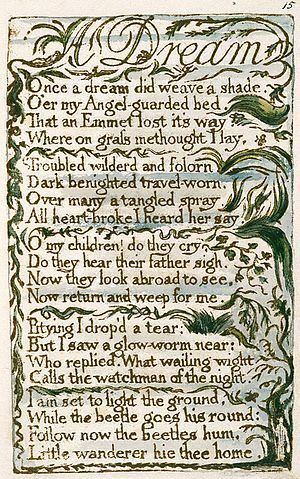Originally published 1789 | ||
 | ||
Similar William Blake books, Other books | ||
"A Dream" is a poem by English poet William Blake. The poem was first published in 1789 as part of Blake's collection of poems entitled Songs of Innocence.
Contents
Background
Songs of Innocence is a collection of 19 illustrated poems published in 1789. According to scholar Donald A. Dike, the collection does not “describe an absolute state of being or fashion an autonomous truth.” Rather, he says the poems are resistant, being “consciously against something and trying to see their way through something.”
Songs of Innocence was followed by Blake's Songs of Experience' in 1794. The two collections were published together under the title Songs of Innocence and of Experience, showing the "two contrary states of the human soul.”
The Poem
Once a dream did weave a shade
O'er my angel-guarded bed,
That an emmet lost its way
Where on grass methought I lay.
Troubled, wildered, and forlorn,
Dark, benighted, travel-worn,
Over many a tangle spray,
All heart-broke, I heard her say:
'Oh my children! do they cry,
Do they hear their father sigh?
Now they look abroad to see,
Now return and weep for me.'
Pitying, I dropped a tear:
But I saw a glow-worm near,
Who replied, 'What wailing wight
Calls the watchman of the night?
'I am set to light the ground,
While the beetle goes his round:
Follow now the beetle's hum;
Little wanderer, hie thee home!
Structure and Summary
“A Dream” is composed of five quatrains using an AABB rhyme scheme. Blake heavily relies on alliteration, assonance, internal rhymes, and eye rhymes, especially in the first and fourth stanzas, to create a connection between sight and sound.
The poem describes a dream featuring four characters: the narrator, the emmet (an archaic word for ant), the glow-worm, and the beetle. The dream begins with the narrator encountering the main protagonist of the dream, the lost emmet. The worn emmet laments to the narrator about her children back home. The glow-worm, who is “set to light the ground,” becomes the rescuer for the lost emmet. The glow-worm tells the emmet to follow the beetle, who will guide the emmet home.
Themes and Critical Analysis
Isabelle Keller-Privat describes “A Dream” as a piece that, like other Songs of Innocence poems, “emphasizes the interconnections between the actors, the voices and the rhythms that give the poem its coherence and harmony.” This coherence and harmony give the poem its sense of innocence. The world of this poem is portrayed as friendly and the characters are helpful. Yet a hint of experience can also be felt in “A Dream” through the emmet’s fear of its surroundings and its tired, damaged appearance. The emmet has experienced hardship and separation beyond the innocence of the dream.
Dike writes that, by putting the dream’s concerns into the world of an insect, Blake extends the “usual limits of sympathy.” Resolution is found for the emmet through cooperation with the other characters of the dream. According to Dike, this introduces the theme that everyone is imperfect and needs help because the emmet requires the assistance of the narrator’s sympathy, the glow-worm’s rescue, and the beetle’s guidance.
Maternity Plot
Harriet Kramer Linkin explores the inverted maternity plot present in "A Dream." In many of the poems in Songs of Innocence, Blake portrays mothers as nurturing and protective. However, as Linkin writes, in "A Dream" the "inversion of a popular narrative of idealized maternity pointedly suggests that the domestic ideology is nothing more than a fantasy of Generation." Rather than a father returning to his waiting wife and children, the mother is the one returning to her husband and children at home. This maternity plot in "A Dream" follows a trend of absent mothers in other Songs of Innocence poems. According to Linkin, Blake "attends to the problematic institution of a domestic ideology that restructures the middle-class family."
